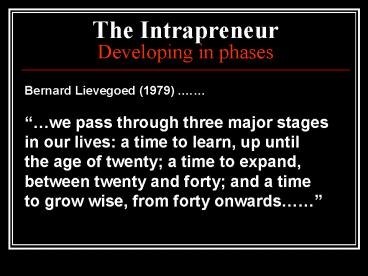The Intrapreneur Developing in phases - PowerPoint PPT Presentation
1 / 14
Title:
The Intrapreneur Developing in phases
Description:
we pass through three major stages. in our lives: a time to learn, up until ... Your pathfinding attributes. Capacity for insight. Possession of foresight ... – PowerPoint PPT presentation
Number of Views:732
Avg rating:3.0/5.0
Title: The Intrapreneur Developing in phases
1
The IntrapreneurDeveloping in phases
Bernard Lievegoed (1979) . we pass through
three major stages in our lives a time to
learn, up until the age of twenty a time to
expand, between twenty and forty and a time to
grow wise, from forty onwards
2
Negotiating your lifes coursesYour pathfinding
attributes
- Capacity for insight
- Possession of foresight
- Tolerance of uncertainty
- Willingness of risk
- Courage to change
3
The Entrepreneur
- Three meta-definitions
- As a performer of managerial tasks
- An agent of economic change, and
- As an individual with a particular personality
- All three complement each other
- Specify entrepreneurs by the task that they
perform.
4
Intrapreneurism
- Entrepreneurial organisation
- accepts (even a need for) change
- exploits opportunity
- Established organisation
- ability to consolidate around
- success
- manages risk
- control of resource flows
The intrapreneur achieves the synthesis between
established-entrepreneurial.
5
Intrapreneur an entrepreneur who works within
the confines of an established
organisation. Gifford Pinchot (1985). Book
intrapreneuring
Role similar to that of Change
master Kanter, 1985
- Developing and communicating
- organisation vision
- Identifying new opportunities
- Generating innovative strategic options
- Creating organisation wide perspective
- Facilitating and encouraging change
- Challenging existing ways of doing things
- Breaking down bureaucratic inertia
- Gifford Pinchot (1985)
6
- Four levels of intrapreneurial activity
- Within Outside
- These differ on the impact on
- The organisation and its surroundings
- Ventures stakeholders
- Resources required
- Level of risk
- Management of specific projects
- Setting up of new business units
- Reinvigorating the whole organisation
- Reinventing the businesss industry
7
The management of specific projects
- Typically,
- NPD
- Exploitation of new market opportunity
- Integration of new technology
- New funding for maintaining competitive edge
- How is it done
- Managed intrapreneurially, cutting across
conventional boundaries - Perhaps, may be made responsibility of a cross
disciplinary team - operating with entrepreneurial flair
8
The setting up of new business units
- Structure
- External strategic issues
- Resources (including HR)
- Relationship with parent business
Best to have members of the entrepreneurial team
manage these projects, as they may have a
future role
9
Reinvigorating the whole organisation
- Flexibility and responsiveness to new and unmet
customer demands - Reintroduce inventive spirit back it is a
radical process! - An intrapreneur must lead with entrepreneurial
vision, leadership and motivation, and overcome
resistance to change.
Loss of flexibility as the organisation grows!!!
Internal concerns
10
Reinventing the businesss industry
- Entrepreneurs reinvent the industries they
- operate in by introducing
- New technology
- Delivering new products
- New processes
- Businesses can win by playing or changing the
rules - Either requires strategic thinking, vision, risk
taking and - leadership.
- Here, intrapreneurship entrepreneurship
11
Limitations to intrapreneurship
- Entrepreneurs comfort Entrepreneurs who have
created the company must let go so that
intrapreneurs can operate. - (It is about breaking rules which entrepreneurs
have created (Young, 1999) - Decision-making controlBalance needed between
freedom for the intrapreneur and maintaining the
business on a constant strategic path.
12
Limitations to intrapreneurship
- Internal politics Intrapreneurs must be able to
predict and understand internal resistance to
change. Thrive on chaos (Tom Peters, 1989) - Rewards Can the organisation offer the same
rewards as those expected by entrepreneurs?
(economic, social and developmental). Moves to
start own venture?
13
Summary
- Venture matures (consolidation)
Changes to financial, strategic, structural
and organisational dynamics
Chance to create a defendable competitive
position
Intrapreneurism offers the venture a way of
combining the flexibility and responsiveness of
the entrepreneurial with the market power and
reduced risk of the established organisation
14
Bibliography and references
- Strategic entrepreneurship, (2001) by Philip A
Wickham, Prentice Hall, ISBN 0273 65115 3, pages
20, 224, 388-91 - Creative Management, (reprinted 1996) Ed. Jane
Henry, Chapter Developing in phases, Ronnie
Lessem, SAGE, ISBN 08039 8491X, Pages 254-65

